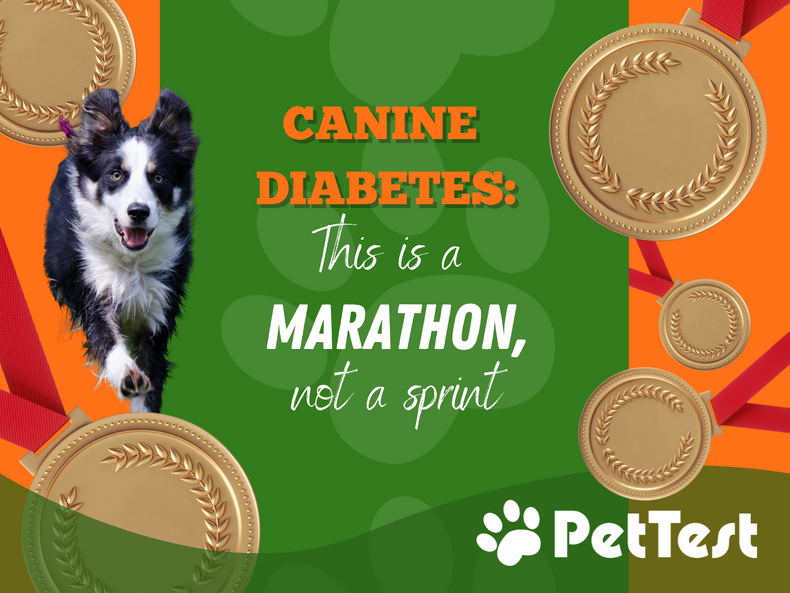Canine Diabetes: This is a Marathon Not a Sprint!
I am not a patient person and it is something that I have had to work on most of my life. “Patience takes practice” runs through my head constantly, but it was really going through my head in overdrive after Lucy healed from pancreatitis. My goal to get her blood glucose to target range and weight to target range ended up taking seven months and I was really frustrated and stressed out.
When Lucy was diagnosed with acute pancreatitis and diabetes she needed to recover from pancreatitis and I had to make immediate changes. Low-fat diet, scheduled meals, subcutaneous fluids, medication and of course insulin injections were all a new way of life. I was most concerned about the pancreatitis so I did not dive into canine diabetes; she was fed every twelve hours and got her insulin, but I was not immediately concerned about diabetes. Luckily Lucy healed quickly so I started working on diabetes soon after.
Target range, diabetic ketoacidosis (DKA), chronic pancreatitis, diabetic cataracts, UTI’s, weight loss.
All these things plagued me. It was overwhelming and I wanted Lucy fixed now but there was setback after setback.
Why did I have all these setbacks?
Because I was trying to fix everything at the same time. I was running curves while switching food. I switched Lucy’s food from prescription to homemade then back to prescription. She lost a lot of weight and I realized I was under feeding her. I corrected food quantities then I took a step back. I could not continue in the manner I was; it was not healthy for Lucy, me or the household.
Canine diabetes is a marathon not a sprint!
Once I figured out that we were in a marathon and not a sprint, and that I needed to change one thing at a time I started understanding canine diabetes.
I switched Lucy’s insulin six months after diagnosis. She started out on Vetsulin but curves were never consistent and she would dip quite low. After I switched her to Novolin N I ran curves every seven days, sent the completed curve to my vet and we discussed increases. Increases were half a unit each time and within month blood glucose levels were much more consistent.
Once her BG levels were better I concentrated on food. Lucy had lost 5.6 lbs.; she was 22 lbs. at diagnosis and dropped to 16.4 lbs. This was due to a combination of insulin not working properly (hence the change) and high fiber diet. I lamented over changing her food since she had had pancreatitis, and I was worried I would cause a flare up. I slowly transitioned her to a commercial dog food over a 14-day period, thankfully she did well with the new food and she loved it. Once she was completely transitioned and her blood glucose leveled out Lucy started gaining about one pound per week until she finally hit her target weight of 20.5 lbs.
Finally, after a little over seven months into diagnosis Lucy was a healthy weight, blood glucose was in target range, she was playing with Frank and back to chasing squirrels.
Could I have gotten all of this done in less than seven months? If I knew then what I know now, I believe I could have. I did not understand canine diabetes and I was impatient. Once I slowed myself down, made one change at a time, learned to be patient and trust the process everything came together.
My tips for any new diabetic dog parents are as follows:
- Make one change at a time. Multiple changes at the same time make it impossible to know what is or is not working.
- When working on adjusting insulin to get to target range, curves should be run every seven to ten days. Increases are typically only half a unit, especially once BG is below 300 mg/dL (16.66 mmol/L). Increasing insulin too quickly can cause rebound/Somoygi Effect and breaking rebound/Somogyi Effect is a big step back in managing canine diabetes.
- Target range for blood glucose: 100 – 250 mg/dL (5.55 – 13.88 mmol/L). If you don’t know how to run a curve, please click here for a recent blog I wrote.
- When changing food transition over a ten-day period. A longer transition is recommended for diabetic dogs due to blood glucose fluctuations and possible GI upset.
- Ask questions, read from credible sources and find a support system that works for you. I have been an administrator in Diabetic Dog Owners on Facebook for over five years and I can tell you that joining a group of like-minded people does help. We have all been in there, understand and empathize.
- Take a deep breath, be kind to yourself, take breaks! Diabetes diagnosis can be overwhelming but you will get it down. And remember, this is a marathon not a sprint!
Until next week stay comfy and caffeinated!
If you have any questions, comments or suggestions, please start a conversation below.
If you are looking for a Facebook community to join for support, I have proudly been an admin in Diabetic Dog Owners for over five years. You can also join Canine Diabetes Support and Information on Facebook as well.
Be sure to join the PetTest family on Facebook and Instagram. PetTest has fun, interactive posts AND they have fabulous giveaways every week!
Do you need a blood glucose meter kit for your diabetes arsenal? Click here to purchase one today!
For a printable version of this blog click here.

